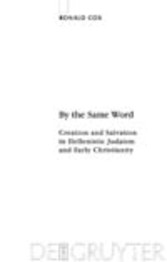Search and Find
Service
More of the content

By the Same Word - Creation and Salvation in Hellenistic Judaism and Early Christianity
Chapter Six (S. 352-353)
Conclusion
6.1. Thesis Statement
This is a study of how three sets of writings share a common cosmological tradition but appropriate that tradition in three distinctive ways. The method of this study was to explain the source tradition and then describe its appropriation in the three sets of writings. The thesis was two-fold: first, Middle Platonic intermediary doctrine persists as “a surviving mythic form” in Hellenistic Jewish sapientialism, early Christology, and Gnostic creation myths, and second, the presence of this intermediary doctrine provides “cosmic dimension and transcendent meaning” to their differing salvific schemes.1
6.2. First Move – The Source Tradition: Middle Platonic Intermediary Doctrine
In a move ad fontes, the study began by considering how the Middle Platonists rehabilitated the physics of their Athenian master. Although they adhered to Plato’s postulation of a transcendent principle, subsequent criticism (especially from the Peripatetics and Stoics) constrained the Middle Platonists to explain how that transcendent principle could have cosmic efficacy and not lose its transcendence. Hence, Plato’s Hellenistic followers formulated a second, intermediary principle between the Monad and physical creation. While they construed it differently (ranging from the thoughts in God’s mind to a separate, divine entity), the Middle Platonists were consistent in affirming that the intermediary principle shared the Monad’s transcendent, noetic character while mediating that character to the material creation.
They articulated the transcendent character and mediating function of the intermediary in two noteworthy ways. One is the common motif of the intermediate principle as a copy, a paradigm of the Monad. In this capacity, the intermediate principle served as divine eQj¾m or exemplar for the material world, which was thus a copy of a copy of the Monad. Additionally, a number of Middle Platonists used prepositional phrases as another way to denote the principle’s character and function. This metaphysics of prepositions served as philosophical shorthand to reinforce the distinctiveness of Middle Platonic doctrine over against Peripateticism and Stoicism.
Finally, as concerned as they were about protecting the transcendence of the Supreme Principle, Middle Platonists were also concerned about humanity achieving its t´kor. While the evidence is less than abundant, it appears once again the intermediate principle played the indispensable role here. Whether as the object of contemplation or as an active anagogue, the intermediary fostered the liberation of the rational soul from the body and its return to its transcendent source.
6.3. The Second Move – Hellenistic Jewish Sapientialism: The Divine Intermediary and the Fulfillment of Cosmology
The next move of the study was to show how, despite the numerous qualitative differences between Wisdom of Solomon and Philo’s writings, they both used Middle Platonic concepts and terms to present an intermediary that is ontologically related to God, that is responsible for creating and governing the cosmos by God’s power, and that fosters humanity finding its ultimate fulfillment in God.
Wisdom of Solomon, drawing from the heady currents of contemporary religious and philosophical trends and combining these with an authoritative sapiential tradition, renders an engaging portrait of Sophia, she who is both God’s throne companion and humanity’s boon. Pseudo-Solomon presents Sophia’s role as throne companion as being much more involved than earlier renditions of personified Wisdom.
All prices incl. VAT











